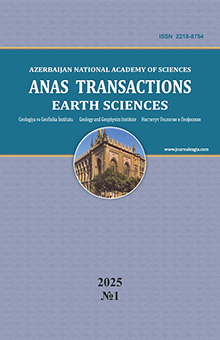№ 1,
2019
Download the article
3D geophysical model of near surface structure of the Dashgil mud volcano
Geology and Geophysics Institute, Azerbaijan National Academy of Sciences 119, H.Cavid ave., Baku, AZ1143: avazsalamov@mail.ru
Summary
A-
A+
The article discusses the results of geophysical studies (electrical, geothermal and gravimetric) conducted in the crater area of some mud volcanoes. Despite the shallow depth (up to 200 m) of electrical exploration, in combination with other methods, they provide a convincing in-sight into the structure of the studied area (the crater zone of the Dashgil mud volcano). A joint analysis of these results suggests the existence of subvertical zones in the cross-section with physical properties differing from the ones of the rocks characterizing the environment. Roots (an area where erupting fluids are accumulated) and channels of mud volcanoes are defined as decompressed objects. Fluids that carry heat from the deeper areas to the surface constantly leak through these channels. Therefore, the channels of mud volcanoes relative to the surrounding rocks are distinguished by high temperatures and temperature gradients. On the surface, thermal anomalies are noted only with the activation of volcano or its eruption. The three-dimensional model built based VES (Vertical Electrical Sounding) results allows visually assuming this assumption. According to the VES data, a supposed lithographic-geophysical section was plotted allowing distinguishing the layers of breccia of each eruption case.
Keywords: mud volcano, structure, сrater, throat, geophysical investigations, Vertical Electrical Sounding (VES), model, temperature, gradient, heat flow
REFERENCES
Aliyev Ad.A., Guliyev I.S., Rakhmanov R.R. Catalog of eruptions of mud volcanoes of Azerbaijan (1810-2007). Nafta-Press. Baku, 2009, 110 p. (in Russian).
Alizadeh S.A., Bayramov A.A., Mammadov A.V., Shirinov N.Sh. Geology of Quaternary sediments of Azerbaijan. Elm. Baku, 1978, 159 p. (in Russian).
Electrical survey. Textbook on electrical exploration practice for students of geophysical specialities. Khmelevsky V.K., Modin I.H. and Yakovlev A.G. (ed.). Nauchny mir. Moscow, 2005, 311 c. (in Russian).
Galin D.L. Interpretation of engineering geophysics data. Nedra. Moscow, 1989, 114 p. (in Russian).
Hamza V.M., Cardoso R.R., Ponte Neto C.F. Global heat flow: fantasy and facts. Sixth Intern. Meeting “Heat flow and the structure of the lithosphere”, Bykov near Pilsen, Czech Republic, 2006, 24 p.
Kadirov F.A., Mukhtarov A.Sh. Geophysical fields, deep structure, and dynamics of the Lokbatan mud volcano. Izvestiya, Physics of the Solid Earth, V. 40, № 4, 2004, pp. 327-333.
Kholodov V.N. Mud volcanoes: distribution and genesis. Geology and mineral resources of the World Ocean, № 4, Moscow, 2012, pp. 5-27 (in Russian).
Kopf A., Stegmann S., Delisle G. et al. In situ cone penetration tests at the active Dashgil mud volcano, Azerbaijan: Evidence for excess fluid pressure, updoming, and possible future violent eruption. Marine and Petroleum Geology, V. 26, 2009, pp. 1716-1723.
Mukhtarov A.S., Adigozelov N.Z. Thermal regime of East Azerbaijan mud volcanoes. Proceedings of Geology Institute of AS Azerbaijan, № 26, 1997, pp. 221-228 (in Russian).
Mukhtarov A. Heat transfer by fluids of mud volcanoes and hydrothermal processes. Proceedings of the 38th Conference of Sosiete Internationale des Techniques Hydrothermales and the 56th Annual Meeting of the Balneological Society of Japan. Beppu, Japan, 2003, pp. 295-300.
Mukhtarov A., Kadirov F., Guliyev I., Lerche I. Temperature evolution in the Lokbatan mud volcano crater (Azerbaijan) after the eruption of 25 October 2001. Energy Exploration & Exploitation, V. 23, № 3, 2003, pp.187-207.
Olenchenko V.V., Shnyukov E.F., Gaskova O.L., Kox S.N., Sokol E.V., Bortnikova S.B., Eltsov I.N. Dinamics of eruption of mud volcano sopka Andrusova (Bulganak mud volcanic focus, Kerch peninsula). Doklady AS, V. 464, № 2, 2015, pp. 214-219 (in Russian).
Popov E.A., Ten K.M., Funtikov G.N., Selyakov V.I., Glushko S.P. Guidelines for the use of VES for the detailed dissection of the section in solving geological and engineering-geological problems. Rotaprint. Moscow, 1990, 52 p. (in Russian).
Salamov A.M., Kadirov A.G., Salamov F.A., Pashayev T.R. Investigation of the landslide in the Khizi region of Azerbaijan by the method of Vertical Electrical Sounding. Inzhenerniye izyskaniya (engineering survey), № 5-6, 2015, pp. 50-56 (in Russian).
Smirnov Ya.B. Thermal field of the USSR territory (explanatory note to the maps of heat flow and deep temperatures on a scale of 1: 10,000,000). GUGK. Moscow, 1980, 150 p. (in Russian).
Yakubov A.A., Alizadeh A.A., Zeynalov M.M. Atlas of mud volcanoes of the Azerbaijan SSR. Elm. Baku, 1971, 258 p. (in Russian).
DOI:
10.33677/ggianas20190100024
